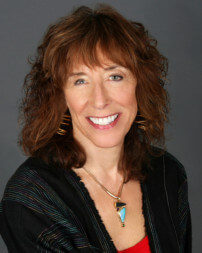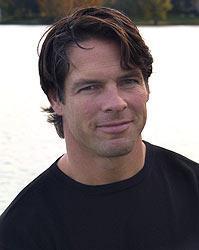Tamron Hall has long been a household name. She’s reported on and anchored major news stories for NBC and MSNBC, she became the first Black woman to host “TODAY” in 2014 and her Emmy-winning “Tamron Hall Show” is in its third season. Now she makes her debut as an author with As the Wicked Watch, which introduces readers to Jordan Manning. A savvy and dedicated crime reporter, Jordan is determined to find justice for two young Black girls found murdered in Chicago, despite pushback from the police and ever-increasing danger as she gets closer to the truth. Hall talked to BookPage about life on the crime beat, her transition from TV to the page and why Chicago is close to her heart.
Congratulations on becoming an author! Will you introduce us to the intrepid Jordan Manning?
We follow Jordan, a young woman from Texas, now in Chicago, who becomes obsessed with a case that comes in through a call to her hotline number. Jordan is a complicated and very interesting woman. She’s at a critical point in her career where a national network job is looming over her head as an option, but her ties to Chicago and the people there keep her grounded. She started out believing her path would involve forensic science. Through life and her journey, she realized being a reporter and investigating was more for her than being in a lab and analyzing information.
Did going from telling stories on TV to crafting them on the page feel like a natural transition? What was the hardest, easiest or most fun thing about embracing your inner author?
The most interesting part of this journey for me was piecing together the case in my book and how it would be solved. It was inspired by two cases I covered years ago in which children were not given the justice or care they should have received, whether it was the victims or the children who were accused of a heinous crime. For me, it was a natural transition. I wanted the book to read like a newscast. I wanted it to feel urgent, with the tone and the experience of a reporter. I was able to reflect on personal experience instead of having to interview reporters and get their take on what it’s like.
You’ve had and are having quite the impressive career, complete with major TV network jobs, talk show syndication, an Emmy win and more. What made you want to add author to your resume?
I’ve thought about the two cases that inspired this novel—one in Texas and one in Chicago—since the late 1990s, when I covered them. I’ve always wanted to write a novel, but I didn’t know exactly what Jordan’s journey would be. In the middle of the night, it started to flood my mind. Perhaps being home more [during the COVID-19 pandemic] and needing a creative outlet in addition to the “Tamron Hall Show” was how this book was born. My experiences as a reporter on “Deadline: Crime” to reporting on the streets of Bryan, Texas, Chicago and New York City are all part of this journey.
“I wanted the book to read like a newscast.”
You’ve worked in morning television for some 25 years and must have that early riser routine down! Did that play a role in setting up your writing routine? Do you have a preferred writing spot, snack, music, etc.?
Morning TV absolutely helped my routine. I wake up naturally at 4:30 a.m., and during the COVID-19 pandemic, we were taping my show later in the day. Every morning I would wake up early, grab a cup of coffee and just start writing. Twenty-five years of this early morning routine definitely allowed me the space to be creative when writing.
As Tam Fam members will note, there are many similarities between you and Jordan Manning, from the cities you’ve worked in to a particularly fabulous haircut. What are some ways Jordan is different from you?
Jordan is a lot more anxious than I am. Of course, I am eager to do things and I get excited. But I don’t think that I have the same level of anxiety as she does. She’s also much more noncommittal than I was when I was dating. She is very much about moving past each guy quickly. Not that that’s a bad thing, that just wasn’t my particular journey in dating.
Anyone who’s seen you on TV knows you have an eye for fashion, and Jordan’s also a snappy dresser—including her trademark stiletto heels. Do you have any fashion talismans that help you feel at home no matter where work takes you?
I think for me, it’s my hoop earrings. No matter where I am, my hoop earrings ground me professionally and personally.
Chicago is the vibrant and dramatic backdrop for Jordan’s story. What about the city made you decide to choose it as the setting for As the Wicked Watch?
Chicago was a transformational part of my career. It was my first major market; Chicago was the last building block before going to the national news. I also felt the dynamic of policing and community all fit into the landscape. The politics, the policing issues, the fact that the city is so segregated according to those who live there and reported on it—it was a setting that made sense for Jordan’s journey.
“No matter where I am, my hoop earrings ground me professionally and personally.”
Jordan contends with racism and sexism on a daily basis. Although she’s developed coping strategies, it still takes a major toll. What do you hope readers take away from your book in terms of what it’s like to be a woman of color in the newsroom?
I hope that people take away the reality of being in a newsroom. It is ironic that many of the stories about these issues are reported by reporters who are also experiencing them. Imagine being a reporter discussing a company that’s gotten in trouble because of a discrimination case, and you are facing that same type of discrimination within your workplace. It was only recently that we started talking about these things within the news industry. That’s the challenge for female reporters and reporters of color.
Jordan has never understood why college journalism courses are lumped in with marketing and advertising courses. “The disposition my job requires is more akin to a surgeon’s or a psychiatrist’s,” she says. Will you elaborate on that a bit for us?
I think what she means by that and why she compares it to being a surgeon is because it is so precise and so strategic. It is a very focused and fine line, and I think that people underestimate that. You can’t be off the cuff, you can’t go in without a plan. As a psychiatrist, you have to, for lack of a better description, get into someone’s mind. For Jordan, being on the investigative team, she has to think like a police officer, she has to think like someone who has done something nefarious, she has to think like a victim and then ask, “How did this happen?”
Your book shines a light on the differences in how criminal cases are treated by the police, the press, politicians, etc., depending on the race, gender, age and other attributes of the victims. Do you think there’s hope for improvement or change?
I believe that there is hope, but if I’m honest, there are days when I think there isn’t. Whether it’s George Floyd, Trayvon Martin, Tamir Rice or Breonna Taylor, for every example of progress, you are given the gut-punch realities of injustice. I think this book shows us both.
This is your first Jordan Manning mystery. Do you already have another one in the works? (No pressure!) Is there anything else you want to share in terms of what’s coming up next for you?
I’m already four chapters into the next part of her journey. It takes her a little outside of Chicago, and we’re already starting to see more reckless behavior from her to show how committed she truly is to solving cases. Is she willing to put her own livelihood and safety on the line?

































